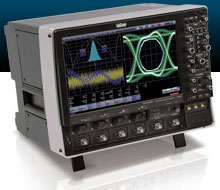Teledyne LeCroy SDA 820Zi Data Analyzers

Follow us for the latest equipment specials.
Refurbished Teledyne LeCroy SDA 820Zi

Sell Equipment Repairs Add to cart E-mail this page Alert me when this goes on sale
Teledyne LeCroy SDA 820Zi Details
Teledyne LeCroy SDA 820Zi
Bandwidth: 20.0 GHz Channels: 4
20 GHz, 80 GS/s, 2ch, 20 Mpts/Ch Digital Bandwidth Interleaved (DBI) Serial Data Analyzer with 15.3"
A Total Solution for Serial Data Analysis
Unleash the power of serial data analysis for understanding and characterizing your design, proving compliance and understanding why a device or host fails compliance. The Quad Summary View of the SDA II software always shows the eye, TIE, bathtub curve and jitter histogram. No other Serial Data Analyzer lets you see the simultaneous interaction and real-time changes in all four views. The X-Stream II Architecture provides fast updates and the fastest eye interpretation. Combined with up to 512 Mpts record lengths and more complete jitter decomposition tools, SDA II provides the fastest and most complete understanding of why serial data fails a compliance test.
Advanced jitter decomposition methodologies and tools provide more information about root cause. Eye Doctor II Advanced Signal Integrity Tools provide more measurement precision through the use of de-embedding and emulation of cables, fixtures, emphasis, serial data channels, and receivers. All jitter decomposition analysis functions can be zoomed and time correlated to specific serial data or other events, making root cause determination faster and easier.
Automated Compliance Testing
The QualiPHY compliance test suite provides step-by-step instructions for testing compliance on a wide array of serial data standards. The process is simplified with fast, automated test operations, illustrated instructions, connection diagrams, and stop on fail feature. Complete test reporting is also provided.
SDA II – Advanced Tools to Isolate and Analyze
Eye and jitter analysis in the SDA 8 Zi begins with a simple, interactive flow diagram intuitively guides you through the setup of Eye Measurements, Jitter Measurements, or both at the same time.
The SDA 8 Zi Series comes standard with the 80-bit Pattern Trigger installed. The serial trigger operates up to 3.125 Gb/s and supports both 8b10b and NRZ signals, and also includes a recovered clock and data output on the front of the oscilloscope.
The LeCroy’s 8b/10b serial decode option has powerful search capabilities enabling captured waveform searches for user-defined sequences of symbols. Multi-lane analysis decodes up to four simultaneously captured lanes. User selection is provided for PCIe, PCIe 2.0, SAS, SATA, XAUI, generic 8b10b or user-defined 8b10b protocols.
The equalization feature removes the effects created in systems that utilize equalization. Users can view the eye of a waveform as seen by a receiver that employs equalization.
The ISI plot shows data-dependent jitter contributions to the eye pattern for the second-to-last bit of a bit length, set from 3 to 10. This plot measures data dependent jitter (DDj) eliminating the need for a repeating bit pattern.
- The jitter spectrum plot allows viewing of any periodic jitter
- Peak annotation displays the frequencies directly on the spectrum
- The LeCroy spectrum plot allows viewing of DDj removal for maximum comprehension
- Time domain view of jitter shows transient jitter events often missed by viewing can be missed by viewing the histogram alone
- The jitter trend clearly shows any non-stationary jitter seems implied by the preceding jitter trend behavior
- Measured jitter histogram clearly displays unusual jitter distributions like bi-modal or non-Gaussian tails. The raw data view shows possibly lost jitter behavior just by viewing the jitter decomposition
- This unprocessed display gives a high degree of confidence in the accuracy of the jitter decomposition and bathtub curve
Even expensive, high-performance cabling can have an adverse effect on measurements and decrease margin from a design. Cable losses and slow rise times can lead to intersymbol interference (ISI). The cable de-embedding feature removes these adverse effects providing more accurate measurements




